Section 504 of the Rehabilitation Act of 1973
advertisement
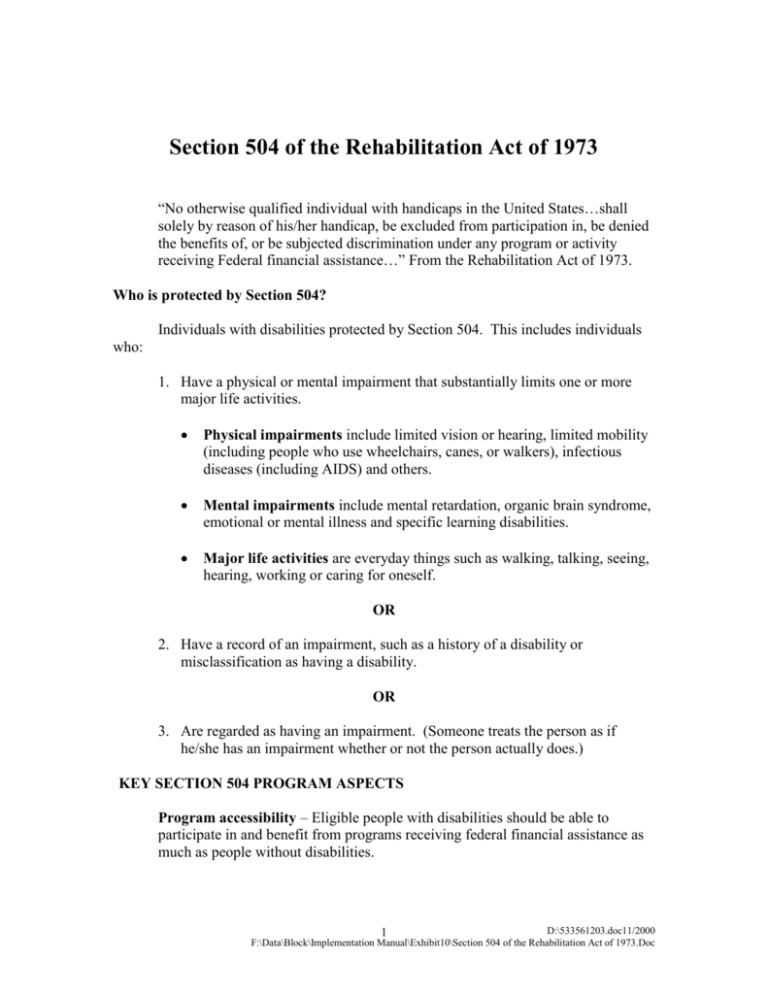
Section 504 of the Rehabilitation Act of 1973 “No otherwise qualified individual with handicaps in the United States…shall solely by reason of his/her handicap, be excluded from participation in, be denied the benefits of, or be subjected discrimination under any program or activity receiving Federal financial assistance…” From the Rehabilitation Act of 1973. Who is protected by Section 504? Individuals with disabilities protected by Section 504. This includes individuals who: 1. Have a physical or mental impairment that substantially limits one or more major life activities. Physical impairments include limited vision or hearing, limited mobility (including people who use wheelchairs, canes, or walkers), infectious diseases (including AIDS) and others. Mental impairments include mental retardation, organic brain syndrome, emotional or mental illness and specific learning disabilities. Major life activities are everyday things such as walking, talking, seeing, hearing, working or caring for oneself. OR 2. Have a record of an impairment, such as a history of a disability or misclassification as having a disability. OR 3. Are regarded as having an impairment. (Someone treats the person as if he/she has an impairment whether or not the person actually does.) KEY SECTION 504 PROGRAM ASPECTS Program accessibility – Eligible people with disabilities should be able to participate in and benefit from programs receiving federal financial assistance as much as people without disabilities. D:\533561203.doc11/2000 1 F:\Data\Block\Implementation Manual\Exhibit10\Section 504 of the Rehabilitation Act of 1973.Doc Physical accessibility – As much as possible, people with disabilities should be able to enter and use building (homes, apartments, libraries, youth centers, office buildings, etc.) which are assisted by HUD. Most integrated setting – People with disabilities should not be separated from nondisabled people or put off by themselves, unless there is no other reasonable choice; or special services must be provided to enable the people with disavilities to live independently. Reasonable accommodation – Agencies operating programs assisted by HUD must make adjustments to allow people with disabilities to enjoy the benefits of the programs, as long as the adjustment is not unduly expensive or burdensome (significant difficulty or expense). Discrimination – Any action by a recipient that denies a qualified individual with handicaps equal treatment or equal opportunity to benefit from programs or activities receiving federal financial assistance. WHAT ARE RECIPIENTS OF HOME REQUIRED TO DO UNDER SECTION 504? Recipients must take steps to ensure that people with disabilities are not discriminated against. The steps and activities include, but are not limited to, the following: Have policies and procedures that do not discriminate – Recipients should make sure that people with disabilities are able to benefit from the programs they provide. Also, program administration should not prohibit qualified people with disabilities from fully participating. Meet the specific requirements of the Section 504 regulations – Every recipient of HOME funds must comply with HUD’s Section 504 regulations. On July 11, 1992, regulations implementing Section 504 of the Rehabilitation Act of 1973 became effective. These regulations (24 CFR Part 8) apply to all organizations, both public and private, which receive or administer federal financial assistance. And, these regulations include specific requirements that a recipient must meet. 1. Install a Telecommunications Device for the Deaf (TDD). The TDD number must be communicated to the public in all communications. Recipients may purchase their own or utilize the KHC TDD number. The recipient must complete the KHC TDD service application and pay a $10 fee. Kentucky Housing Association members will not be charged a fee for TDD service. D:\533561203.doc11/2000 2 F:\Data\Block\Implementation Manual\Exhibit10\Section 504 of the Rehabilitation Act of 1973.Doc 2. Conduct a self-evaluation of policies, practices and facilities. The evaluation must be completed in conjunction with handicapped individuals or groups. Any problems with programs, policies and procedures must be addressed and resolved. 3. Complete a transition plan, implementing the structural changes found necessary in the self-evaluation. Structural modifications, if necessary, must be made within four years. 4. If your organization has 15 or more employees, you must designate a Section 504 coordinator, develop a grievance procedure for disabled employees as part of your personnel policies and notify the public in an ongoing process of the organization’s 504 coordinator and the organization’s 504 compliance status. Make reasonable accommodations – If a person with a disability wants to participate in a program, the agency must make whatever accommodations are needed for the person, as long as they are not unduly costly or burdensome. EXAMPLES OF REASONABLE ACCOMMODATION Reasonable accommodations can involve a wide variety of things. Here are a few examples: A deaf person who uses sign language contacts the city commissioner to say that he or she wants to attend an open meeting the city is having. The city should provide a sign language interpreter for the meeting as a reasonable accommodation. A blind person comes to the agency office to apply for a job. The person cannot read the application form. An agency staff person should read the application to the applicant and fill out the form for him or her. If a disabled resident who rents an apartment needs grab bars in the bathroom, the owner should install them. A single person with a severe disability needs a live-in attendant. The housing agency/owner should place this person in a two-bedroom unit (instead of a onebedroom unit) so that the attendant can also live there. D:\533561203.doc11/2000 3 F:\Data\Block\Implementation Manual\Exhibit10\Section 504 of the Rehabilitation Act of 1973.Doc EXAMPLES OF DISCRIMINATION Discrimination against people with disabilities can take many forms. The following provide a few examples: A person with a disability as a result of AIDS applies for an apartment. The agency or owner refuses to let him or her into the apartment because other residents are afraid they may get the disease. This action would be discriminatory because the decision is based simply upon fears and prejudices about AIDS. A current resident of a nonaccessible dwelling unit becomes disabled. If the housing provider refuses to either make a reasonable accommodation, such as installing a ramp for easy access (if it is not unduly costly or burdensome) or moves the resident to an available accessible unit, the provider discriminates against the resident. SECTION 504 STRUCTURAL REQUIREMENTS (REMOVE PHYSICAL BARRIERS) For New Construction multifamily rental properties, 5 percent of the units in the project must be accessible to individuals with mobility impairments, and an additional 2 percent must be accessible to individuals with sensory impairments. The Section 504 definition of Substantial Rehabilitation multifamily rental properties differs from the HOME definition and includes construction in a project with 15 or more units for which the rehabilitation costs will equal at least 75 percent of the replacement costs. In such developments, 5 percent of the units in the project must be accessible to individuals with mobility impairments, and an additional 2 percent must be accessible to individuals with sensory impairments. When rehabilitation, less extensive than substantial rehabilitation, is undertaken, every alteration to every unit must make the unit accessible to the maximum extent feasible until 5 percent of the units in the project are fully accessible to people with mobility impairments. This provision should provide a powerful incentive to recipients to meet the 5 and 2 percent minimum thresholds. Alterations to common spaces must always make the project accessible to the maximum extent feasible. Structures not undergoing alteration do not have to be made accessible if the program as whole can be made accessible through other means. D:\533561203.doc11/2000 4 F:\Data\Block\Implementation Manual\Exhibit10\Section 504 of the Rehabilitation Act of 1973.Doc For most HOME recipients, compliance with Section 504 will ensure compliance with other fair housing legislation concerned with handicapped accessibility. However, the Fair Housing Amendments should be consulted with regard to rehabilitation of one- to four-unit rental properties. In addition, in any rental property, the Fair Housing Amendments allow people to make alterations to the units at their own expense to ensure accessibility. The usual standards for ensuring compliance with Section 504 are the Uniform Federal Accessibility Standards (UFAS), although deviations are permitted in specific circumstances. D:\533561203.doc11/2000 5 F:\Data\Block\Implementation Manual\Exhibit10\Section 504 of the Rehabilitation Act of 1973.Doc


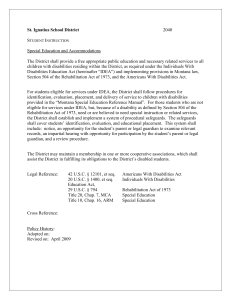
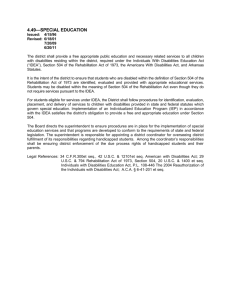


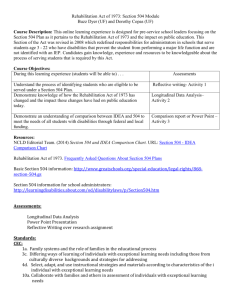
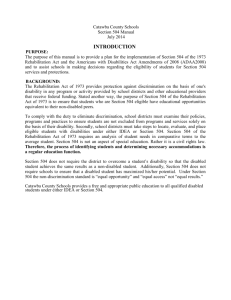
![Education of Children with Disabilities [1]](http://s3.studylib.net/store/data/007268247_1-64d9febbbd62110f46eb5e48441cd460-300x300.png)
